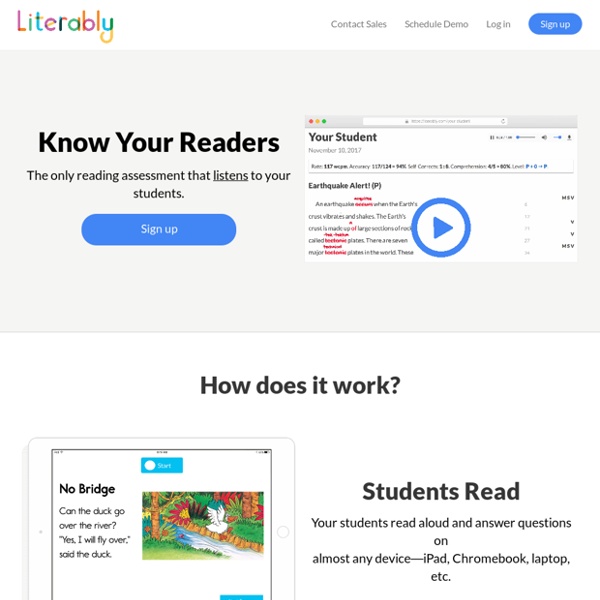



Poetry Editor & Poetry: 10 Ways to Read a Poem 1. Get comfy and enjoy your first reading. Relax into the experience without trying to analyze anything. 2. Read the poem again, this time aloud. Listen for the musicality. 3. 4. 5. 6. 7. 8. 9. 10. © 2015, Mary Harwell Sayler has 3 books of poetry, Outside Eden and Beach Songs & Wood Chimes, published by Kelsay Books in 2014 and, in 2012, Living in the Nature Poem published by Hiraeth Press with an e-book version released in 2014. Learner Sketch Tool The Learner Sketch Tool (LST) is an online tool designed to provide learners with a personalized profile and strategies to improve learning outcomes, and educators with information and strategies for strengths-based conversations that support every learner’s growth and success. The LST is designed to engage learners in an interactive manner and provide information that is immediately practical and useful, increasing successes and empowering students to be advocates of their own learning. Teachers are able to utilize the tool to view an individual student’s self-reported Learner Sketch as well as a group’s composite self-reported strengths and challenges, and access instructional strategies to complement strengths and accommodate/address challenges.
Ways to Use QR Codes for Education QR codes are easy to produce and fun to make, and they'll keep every kid's attention. These pixelated bar codes are digital magic for busy teachers! Use them for everything from running scavenger hunts to polling students. 1. 2. 3. 4. 5. 6. 7. 8. Check out these great ideas from our readers: 9. 10. If you're craving more QR code ideas, watch this short, inspirational video from an amazing Pennsylvania school district. How are you using QR codes in the classroom? How to Improve Your Reading Skills How to Improve Your Reading Skills back The University of Alabama Center for Academic Success 124 Osband 348-5175 Eighty-five percent of college work requires reading. How good are your reading skills? Here are seven steps to help you improve your reading skills: 1. 2. 3. 4. 5. 6. 7.
Children's Library : Free Books : Free Texts Publisher's chromolithographed pictorial wrappers favoritefavoritefavoritefavorite ( 22 reviews ) Topics: Brothers and sisters, Orphans, Conduct of life, Education California Digital Library by Crane, Thomas, b. 1843?; Houghton, Ellen Elizabeth, 1853-1922 texts eye favorite 147 comment 7 Osborne Coll. favoritefavoritefavoritefavorite ( 7 reviews ) Topics: Poetry of places, France -- Description and travel Juvenile literature NY3 favoritefavoritefavoritefavorite ( 5 reviews ) Topic: Drawing -- Study and teaching by Baum, L. favorite 101 comment 2 Publisher's green and red illustrated cloth over boards; illustrated endpapers. by Dalziel, Edward, 1817-1905; Dalziel, George, 1815-1902 favorite 67 comment 11 Publisher's peach wrappers, printed in red, blue, and black favoritefavoritefavorite ( 11 reviews ) Topic: Conduct of life NY3 favoritefavoritefavoritefavoritefavorite ( 1 reviews ) Topic: Drawing -- Study and teaching by Ségur, Sophie, comtesse de, 1799-1874; Sterrett, Virginia Frances favorite 139
EasyTestMaker How to Attach Audio to a QR Code I actually do not have experience with this yet, but it is definitely on my to-do list this year. Here seems to be a pretty simple tutorial on the process at Education QR Codes. You can also use the app Audioboo to assist in QR code creation. I think this will be the method I use. Technochalkie explains a bit how to do it. Ways to Use Audio Texts in the Classroom: 1) Create a QR code of a child reading a book. What else??? Back to QR Code Tutorials FlapJack QR Code Resources Try your hand at QR Codes with these freebies. :) Task Cards MATH 4th-5th Task Cards MATH 2nd-3rd Task Cards FRACTIONS 4th-5th Task Cards MEASUREMENT 4th-5th Task Cards MATH Other Tabitha Carro
Free English Reading comprehension tests and exercises online Reading comprehension is also an important part when you take an English test. Reading comprehension test can help you to improve vocabulary, grammar, and logical thought ability. There are some tips for you to improve reading skills: - Practice reading every day. You should read different fields to improve your vocabulary. - Take note all new words and learn them. - Try to answer all the questions. - After answer all the questions. - Practice reading techniques - scanning, skimming, intensive and extensive reading. + Scanning: You try to find a particular piece of information. + Skimming: You try to gather the most important information as quickly as possible. + Intensive reading: You try to find the details of a specific information. + Extensive reading: You try to find general information of a passage. Elementary Reading Tests
Abracadabra